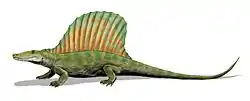| Knoxosaurus Temporal range: Middle Permian, | |
|---|---|
| Scientific classification | |
| Domain: | Eukaryota |
| Kingdom: | Animalia |
| Phylum: | Chordata |
| Clade: | Synapsida |
| Clade: | incertae sedis |
| Genus: | †Knoxosaurus Olson, 1962 |
| Type species | |
| †Knoxosaurus niteckii Olson, 1962 | |
Knoxosaurus is an extinct genus of non-mammalian synapsids containing the species Knoxosaurus niteckii that existed approximately 279.5 to 268 million years ago.[1] It was named by American paleontologist Everett C. Olson in 1962 on the basis of fragmentary fossils from Middle Permian-age deposits in the San Angelo Formation of Texas in the United States.[2] Olson placed Knoxosaurus in a new infraorder called Eotheriodontia, which he considered a transitional group between the more reptile-like "pelycosaurs" and the more mammal-like therapsids. Knoxosaurus and Olson's other eotheriodonts were later considered to be undiagnostic remains of basal synapsids, no more closely related to therapsids than are other pelycosaur-grade synapsids.[3]
See also
References
- ↑ "Fossilworks: Knoxosaurus niteckii". fossilworks.org. Retrieved 17 December 2021.
- ↑ Olson, E.C. (1962). "Late Permian terrestrial vertebrates, USA and USSR". Transactions of the American Philosophical Society. 52 (2): 1–224. doi:10.2307/1005904.
- ↑ Sidor, C.A.; Hopson, J.A. (1995). "The taxonomic status of the Upper Permian eutheriodont therapsids of the San Angelo Formation (Guadalupian), Texas". Journal of Vertebrate Paleontology. 15 (3 Suppl.): 53A. doi:10.1080/02724634.1995.10011277.
This article is issued from Wikipedia. The text is licensed under Creative Commons - Attribution - Sharealike. Additional terms may apply for the media files.





.jpg.webp)